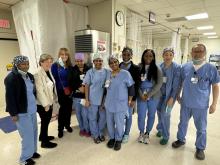Last updated 07.02.2024

The Biden-Harris Administration:
Vice President Kamala Harris has been a vital partner with President Joe Biden in the most pro-labor, pro-worker, pro-public education administration in history.
Her record as district attorney, state attorney general, U.S. senator and vice president shows she knows how to deliver real solutions on the issues.
Supporting Our Nurses and Health Professionals
- Eased Student Debt for Healthcare Workers: Provided student loan relief and supported the Nurse Corps Loan Repayment Program and the National Health Service Corps Loan Repayment Programs, which provide loan forgiveness and scholarships for those working in communities with limited access to healthcare—including rural, urban and tribal communities.
- Increased Access to Student Loan Forgiveness: Strengthened the Public Service Loan Forgiveness program for frontline workers and fixed the income-driven repayment plan for nurses and other healthcare support staff.
- Addressed the Mental Health Crisis Among Healthcare Professionals: Signed the Health Care Provider Protection Act into law, dedicating $135 million in federal funding for programs to promote mental and behavioral health for healthcare providers, remove barriers to accessing care and treatment, and identify and disseminate evidence-based best practices for reducing burnout.
- Acted to Reduce the Gun Violence Epidemic: Signed the Bipartisan Safer Communities Act into law, making $750 million available to help states keep deadly weapons out of dangerous hands, including $231 million for state crisis intervention programs to prevent those who pose a high risk to themselves or others from accessing firearms.
Improving America’s Pandemic Preparedness
- Passed the American Rescue Plan Act: Delivered $1.9 trillion in relief to help American families, businesses and workers recover from the pandemic, including funding to remove the stigma associated with receiving help for mental health and decrease burnout and suicide rates among healthcare professionals.
- Invested in Hospitals: Delivered $240 million in new funding to better prepare hospitals across the country for disasters, emergencies, and new and emerging pathogens.
- Restored the Strategic National PPE Stockpile: Built domestic pipelines for production of personal protective equipment to ensure strategic stockpiles do not become quickly depleted in another national health emergency.
Increasing Access to Healthcare
- Severed Big Pharma’s Stranglehold on Pricing: Signed the Inflation Reduction Act, which forced pharmaceutical companies for the first time to negotiate prescription drug prices with Medicare for many common medications, including insulin, and reined in prices on medicines to treat conditions such as heart failure, blood cancers, kidney disease, rheumatoid arthritis and Crohn’s disease.
- Provided the Largest One-Time Investment in the Healthcare Workforce: Included in the American Rescue Plan was $1.1 billion for community health, outreach and public health education to increase awareness of resources and services available to patients.
- Enrolled More Americans in Health Insurance: Increased the number of insured people to the highest level in history and continued the implementation of the Affordable Care Act, critical for the sustainability of nurses and health professionals.
- Kept Medical Facilities Open: Pushed legislation to prevent funding cuts to hospitals serving uninsured and low-income patients (Disproportionate Share Hospitals) and implemented regulatory changes to help rural hospitals stay open.
Defending Reproductive Healthcare
- Safeguarded Access to Safe and Legal “Medication Abortion”: Protected patients, practitioners and pharmacies to allow for safe, lawful access to abortion medication that the Food and Drug Administration has approved as safe and effective for more than 20 years.
- Championed Health Professionals’ Autonomy in Care: Directed the Department of Health and Human Services to inform patients and providers of their rights and obligations under the Emergency Medical Treatment and Labor Act to protect health professionals and ensure they can provide care based on patients’ well-being.
